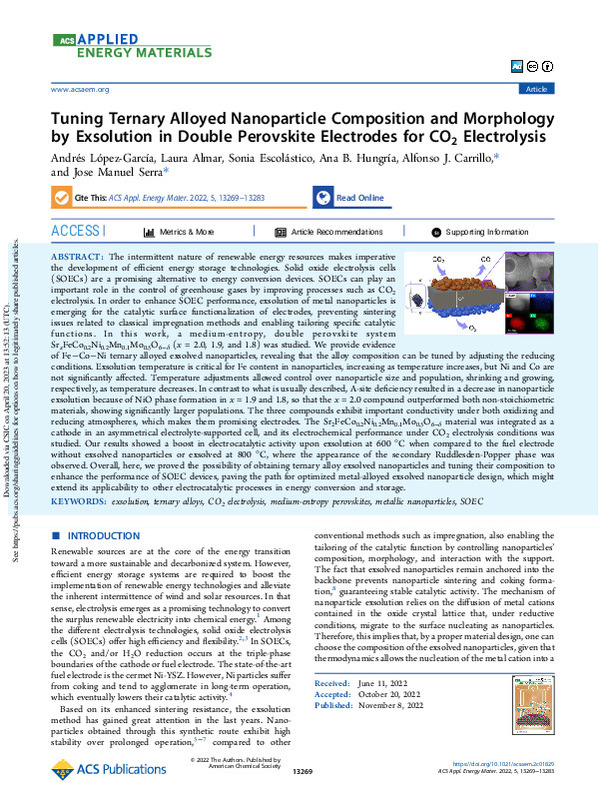JavaScript is disabled for your browser. Some features of this site may not work without it.
Buscar en RiuNet
Listar
Mi cuenta
Estadísticas
Ayuda RiuNet
Admin. UPV
Tuning Ternary Alloyed Nanoparticle Composition and Morphology by Exsolution in Double Perovskite Electrodes for CO2 Electrolysis
Mostrar el registro sencillo del ítem
Ficheros en el ítem
| dc.contributor.author | López-García, Andrés
|
es_ES |
| dc.contributor.author | Almar-Liante, Laura
|
es_ES |
| dc.contributor.author | Escolástico Rozalén, Sonia
|
es_ES |
| dc.contributor.author | Hungría, Ana B.
|
es_ES |
| dc.contributor.author | Carrillo-Del Teso, Alfonso Juan
|
es_ES |
| dc.contributor.author | Serra Alfaro, José Manuel
|
es_ES |
| dc.date.accessioned | 2023-05-22T18:02:13Z | |
| dc.date.available | 2023-05-22T18:02:13Z | |
| dc.date.issued | 2022-11-28 | es_ES |
| dc.identifier.uri | http://hdl.handle.net/10251/193505 | |
| dc.description.abstract | [EN] The intermittent nature of renewable energy resources makes imperative the development of efficient energy storage technologies. Solid oxide electrolysis cells (SOECs) are a promising alternative to energy conversion devices. SOECs can play an important role in the control of greenhouse gases by improving processes such as CO2 electrolysis. In order to enhance SOEC performance, exsolution of metal nanoparticles is emerging for the catalytic surface functionalization of electrodes, preventing sintering issues related to classical impregnation methods and enabling tailoring specific catalytic functions. In this work, a medium-entropy, double perovskite system SrxFeCo0.2Ni0.2Mn0.1Mo0.5O6-delta (x = 2.0, 1.9, and 1.8) was studied. We provide evidence of Fe-Co-Ni ternary alloyed exsolved nanoparticles, revealing that the alloy composition can be tuned by adjusting the reducing conditions. Exsolution temperature is critical for Fe content in nanoparticles, increasing as temperature increases, but Ni and Co are not significantly affected. Temperature adjustments allowed control over nanoparticle size and population, shrinking and growing, respectively, as temperature decreases. In contrast to what is usually described, A-site deficiency resulted in a decrease in nanoparticle exsolution because of NiO phase formation in x = 1.9 and 1.8, so that the x = 2.0 compound outperformed both non-stoichiometric materials, showing significantly larger populations. The three compounds exhibit important conductivity under both oxidizing and reducing atmospheres, which makes them promising electrodes. The Sr2FeCo0.2Ni0.2Mn0.1Mo0.5O6-delta material was integrated as a cathode in an asymmetrical electrolyte-supported cell, and its electrochemical performance under CO2 electrolysis conditions was studied. Our results showed a boost in electrocatalytic activity upon exsolution at 600 degrees C when compared to the fuel electrode without exsolved nanoparticles or exsolved at 800 degrees C, where the appearance of the secondary Ruddlesden-Popper phase was observed. Overall, here, we proved the possibility of obtaining ternary alloy exsolved nanoparticles and tuning their composition to enhance the performance of SOEC devices, paving the path for optimized metal-alloyed exsolved nanoparticle design, which might extend its applicability to other electrocatalytic processes in energy conversion and storage. | es_ES |
| dc.description.sponsorship | The project that gave rise to these results received the support of a fellowship from Spanish Government (RTI2018-102161 grant) and "la Caixa" Foundation (ID 100010434 and grant LCF/BQ/PI20/11760015). Authors acknowledge the use of instrumentation and the technical advice provided by the National Facility ELECMI ICTS, node "Division de Microscopia Electronica"at Universidad de Cadiz. We thank the support of the Electronic Microscopy Service of the Universitat Politecnica de Valencia. | es_ES |
| dc.language | Inglés | es_ES |
| dc.publisher | American Chemical Society | es_ES |
| dc.relation.ispartof | ACS Applied Energy Materials | es_ES |
| dc.rights | Reconocimiento (by) | es_ES |
| dc.subject | Exsolution | es_ES |
| dc.subject | Ternary alloys | es_ES |
| dc.subject | CO2 electrolysis | es_ES |
| dc.subject | Medium-entropy perovskites | es_ES |
| dc.subject | Metallic nanoparticles | es_ES |
| dc.subject | SOEC | es_ES |
| dc.title | Tuning Ternary Alloyed Nanoparticle Composition and Morphology by Exsolution in Double Perovskite Electrodes for CO2 Electrolysis | es_ES |
| dc.type | Artículo | es_ES |
| dc.identifier.doi | 10.1021/acsaem.2c01829 | es_ES |
| dc.relation.projectID | info:eu-repo/grantAgreement/Fundació Bancària Caixa d'Estalvis i Pensions de Barcelona//LCF%2FBQ%2FPI20%2F11760015/ | es_ES |
| dc.relation.projectID | info:eu-repo/grantAgreement/Fundació Bancària Caixa d'Estalvis i Pensions de Barcelona//100010434/ | es_ES |
| dc.relation.projectID | info:eu-repo/grantAgreement/AEI//RTI2018-102161-B-I00//CONVERSION DIRECTA DE CO2 EN PORTADORES DE ENERGIA QUIMICA UTILIZANDO REACTORES ELECTROCATALITICOS DE MEMBRANA/ | es_ES |
| dc.rights.accessRights | Abierto | es_ES |
| dc.description.bibliographicCitation | López-García, A.; Almar-Liante, L.; Escolástico Rozalén, S.; Hungría, AB.; Carrillo-Del Teso, AJ.; Serra Alfaro, JM. (2022). Tuning Ternary Alloyed Nanoparticle Composition and Morphology by Exsolution in Double Perovskite Electrodes for CO2 Electrolysis. ACS Applied Energy Materials. 5(11):13269-13283. https://doi.org/10.1021/acsaem.2c01829 | es_ES |
| dc.description.accrualMethod | S | es_ES |
| dc.relation.publisherversion | https://doi.org/10.1021/acsaem.2c01829 | es_ES |
| dc.description.upvformatpinicio | 13269 | es_ES |
| dc.description.upvformatpfin | 13283 | es_ES |
| dc.type.version | info:eu-repo/semantics/publishedVersion | es_ES |
| dc.description.volume | 5 | es_ES |
| dc.description.issue | 11 | es_ES |
| dc.identifier.eissn | 2574-0962 | es_ES |
| dc.relation.pasarela | S\485317 | es_ES |
| dc.contributor.funder | Agencia Estatal de Investigación | es_ES |
| dc.contributor.funder | Fundació Bancària Caixa d'Estalvis i Pensions de Barcelona | es_ES |
| dc.contributor.funder | Universitat Politècnica de València | es_ES |








